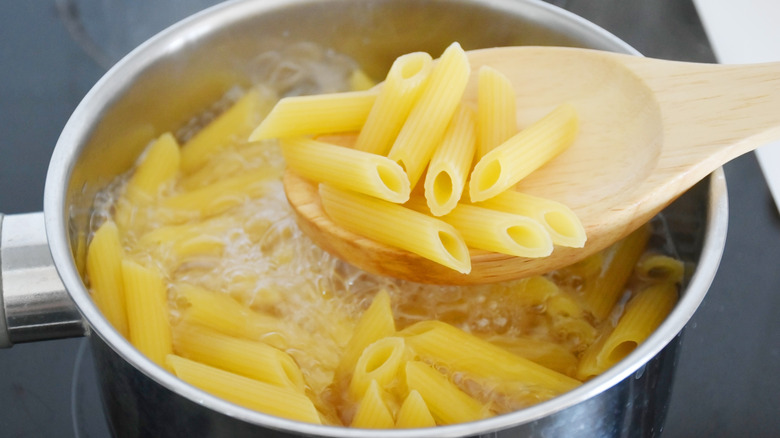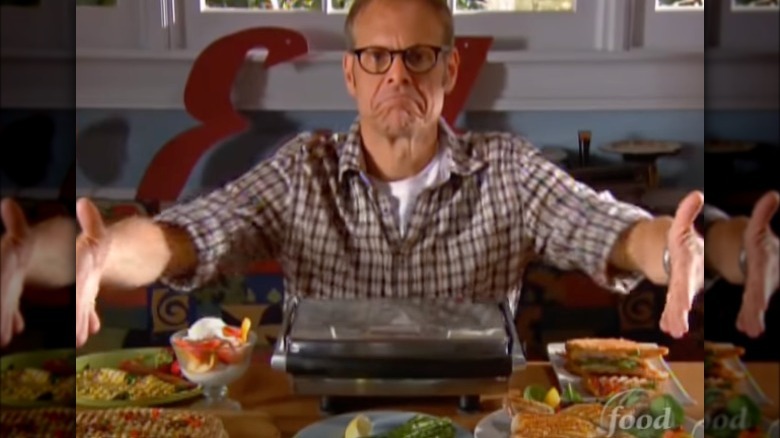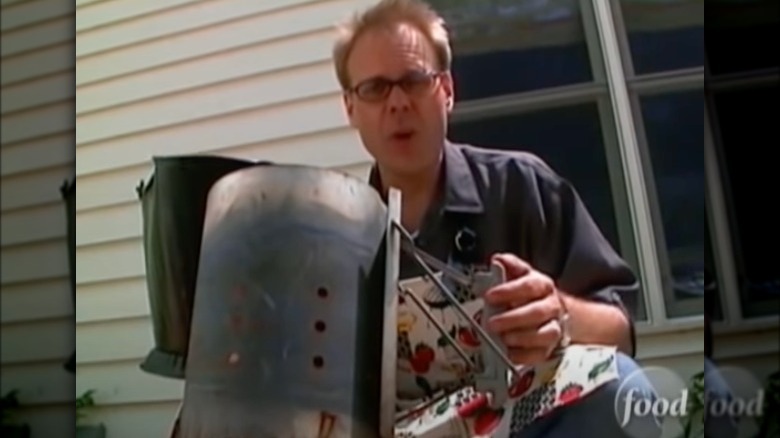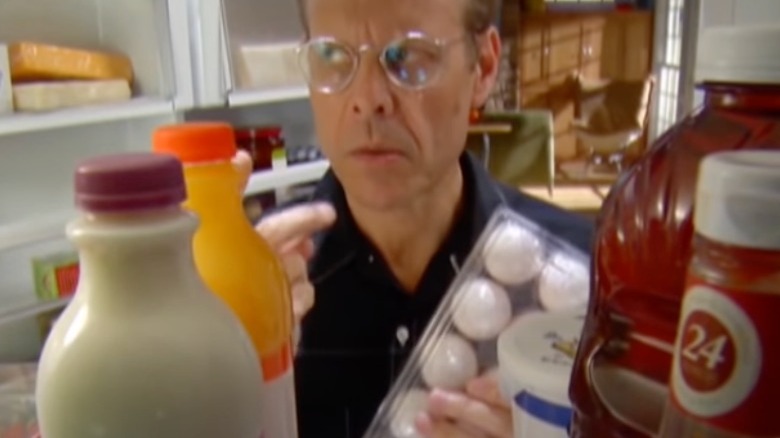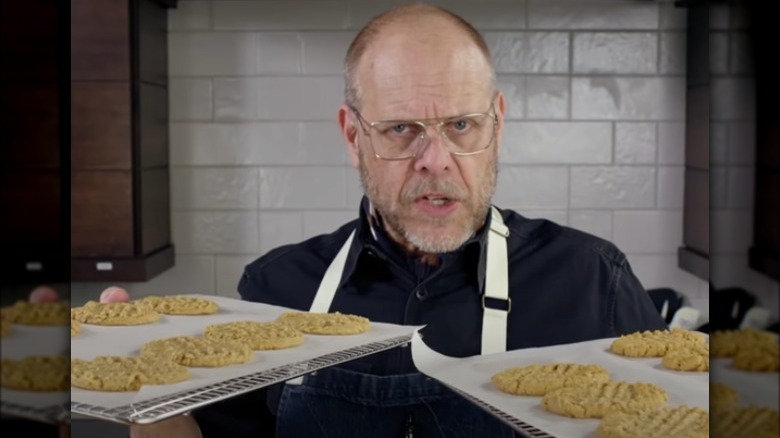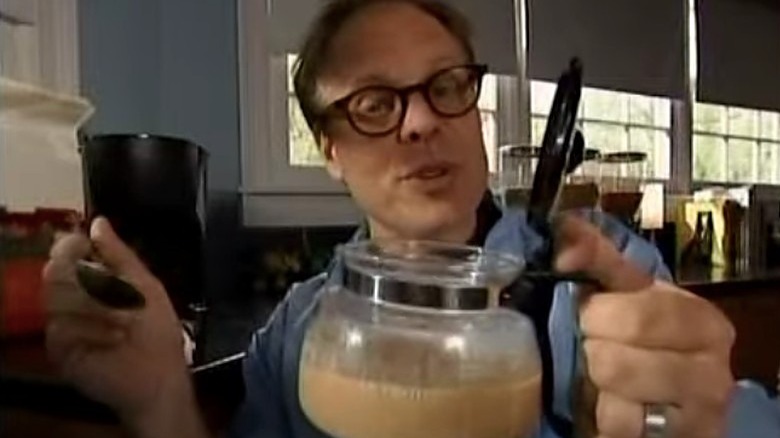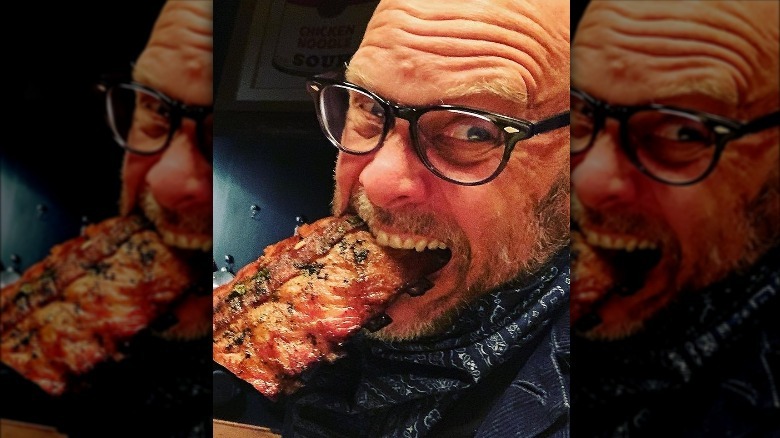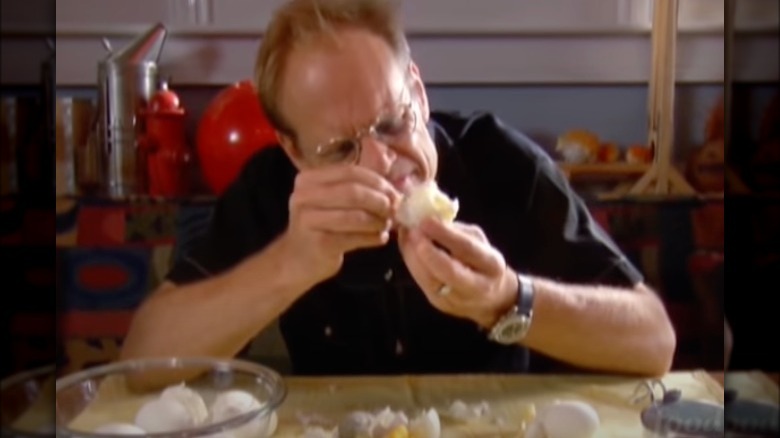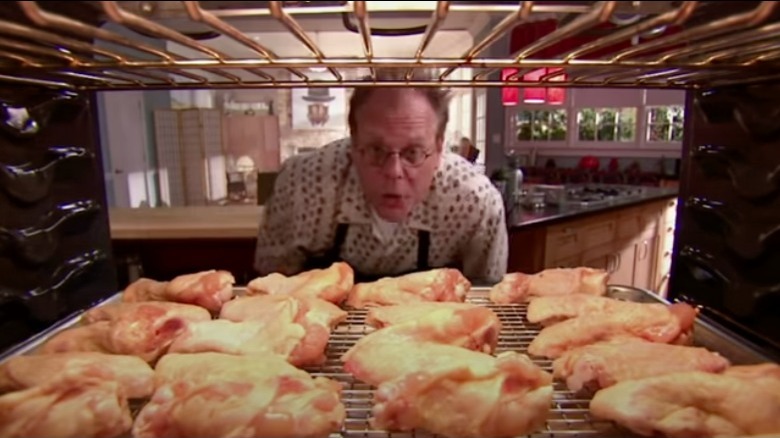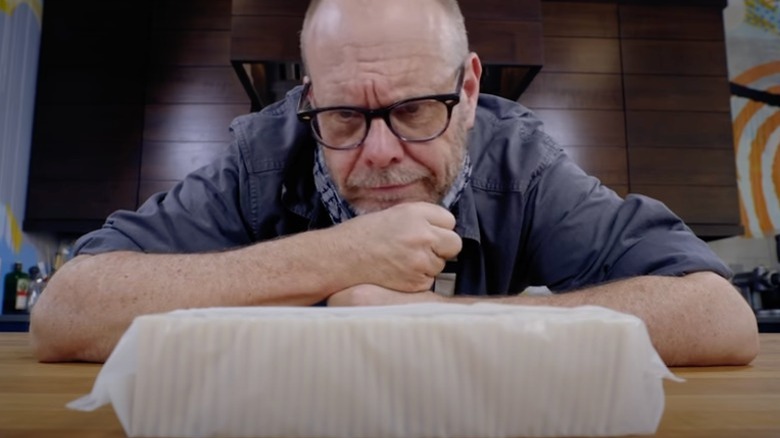Alton Brown's Best Food Hacks
Alton Brown is best known as Food Network's resident nerd. Since his flagship series "Good Eats" premiered in 1999, Brown has been teaching cooking in a scientific way that is anything but boring. His kitchen techniques are very analytical and distinctly his own, occasionally causing some people to disagree with his methods of experimentation.
Brown's entire inspiration for going to culinary school and eventually starting "Good Eats" came from his overall boredom with food television. "I remember I was watching food shows, and I was like, 'God, these are boring. I'm not really learning anything,'" he said in an interview with Bitter Southerner. He did just that with "Good Eats" and its eventual spinoff "Good Eats: The Return" with over 250 episodes (via IMDb). The catalyst to making food science approachable was his assortment of wacky hacks. They somehow worked, and Brown was always quick to explain how and why.
Throughout his career, Brown has taught home chefs some pretty innovative ways to create tasty dishes. His approaches might not necessarily be intuitive, but they tend to work better than expected. We decided to scope out Alton Brown's best food hacks that will hopefully serve to inspire your own creations along the way.
Add pasta to cold water before it boils
There's no doubt that putting together the perfect bowl of pasta is a balancing act between art and science. Most people probably focus on making the sauce, and boiling the noodles becomes a bit of an afterthought. Meanwhile, Alton Brown takes his technique for boiling pasta very seriously, and he claims it will save you time too.
Brown has suggested on "Good Eats" and in his personal blog that the only way to cook pasta is by putting it in cold water before placing it on the burner. Yes, it's counterintuitive to everything we've been taught about making this dinner staple. Brown believes there are many benefits to this method, such as reducing cooking time since you don't have to wait for the water to boil first. Additionally, he says that starting with cold water means using less overall energy to cook the pasta.
The "Good Eats" chef instructs home cooks to place a pot of cold salted water and pasta over a burner on medium heat. Once it starts boiling, reduce it to a simmer until the pasta is cooked. Don't forget to save a cup of water to help emulsify whatever sauce you're serving with the dish. This formula causes the pasta water to be especially loaded with flavorful starch, and it would be a shame to throw it down the drain.
Pop popcorn in a metal bowl
It's almost too easy to throw a bag of popcorn in the microwave and let it do its job while preparing snacks for movie night. Brown will be the first to tell you though, that popping it yourself yields way better results, and it's not even hard to do. His secret is using a large metal bowl to pop the kernels.
Brown mixes ghee, kernels, and salt in a bowl then covers it with foil and pokes holes in the top. Next, he places the bowl directly on a medium flame and shakes it with a pair of tongs. He tells those at home to keep shaking the bowl, even if it seems like nothing is happening. In just a few minutes, you'll have fresh popcorn. Brown recommends topping it with Japanese furikake, nutritional yeast, or sifted cheese powder for an added flavor boost.
A metal bowl makes the best vessel as it allows the already popped kernels to travel to the top and away from the heat source. Meanwhile, the unpopped kernels sink to the bottom to remain closer to the flame, resulting in a primitive-looking, yet shockingly simple cooking strategy (via Southern Living).
Sprinkle salt in your coffee grounds
The first cup of coffee in the morning is something of a ritual for many people. Whether you're using a Keurig one-cup brewer or you're a pour-over expert, everyone has a specific way they like to make their coffee. This doesn't stop Brown from suggesting one simple tip that could transform your cup of joe, and it's using an ingredient you should already have in your spice cabinet.
Brown recommends adding a quarter teaspoon of kosher salt for every six tablespoons of coffee grounds before brewing. "Not only does salt cut the bitterness of coffee, but it also smooths out the 'stale' taste of tank-stored water," Brown writes on Facebook. He says that it isn't enough salt to make your coffee taste like a pretzel, but it will still round out the flavor. Additionally, he claims that research shows that salt is more effective than sugar when it comes to offsetting bitter flavors in dishes.
Grill a whole chicken in a panini press
Brown has a knack for teaching people how to make creative and delicious meals using appliances they might not think of as multipurpose. Take the humble panini press; if you have one, you probably only use it to press sandwiches. Brown, however, believes it is the best tool for indoor grilling. In an Instagram post, Brown shares a video of himself cooking an entire chicken in a panini press. He places a 15-pound weight on top of the appliance for a different take on the old-school chicken under a brick recipe. "I don't need no stinkin' brick," Brown writes in the caption.
Brown has been a panini press advocate for a long time, encouraging people to experiment with the countertop appliance. He's made omelets on it in the past, so it only makes sense that he would feature it as a mini indoor grill. If you try this chicken cooking method at home, it's important to ensure that the internal temperature of the chicken reaches at least 165 F before serving (via USDA).
Spice up your starches with sumac
Every home chef approaches their spice cabinet differently. Some people can't get enough of premade blends that simplify the task of preparing food that's bursting with flavor, while others prefer to break out the mortar and pestle and do things the old-school way. Alton Brown has a lot of secret ingredients, as you probably know by now, including one underrated spice he thinks we should be using more frequently.
Brown loves to add the Middle Eastern spice sumac to dishes, particularly starches like beans, rice, and potatoes (via Food Network). Sumac is made from ground berries from the sumac flower and it infuses acidity into a dish much like the effect of lemon juice. In fact, BBC Good Food points out that sumac can be used instead of lemon or lime juice in any recipe — salad dressings, fish, poultry, etc. It's easy to see how this zippy spice could totally transform a basic weeknight side dish into something otherworldly.
Rethink how to grill with a chimney starter
Using a chimney starter is pretty standard for anyone with a charcoal grill, as it's one of the easiest ways to get it fired up quickly. Typically, a chimney is used as a compact vessel to start a fire with coals before transferring it to a grill. However, Brown recommends placing a chimney starter with coal and newspaper on top of your grill grate while it heats up. Once it is piping hot, remove the chimney, brush off any ash, and lay the steak or whatever you're grilling (a dry-aged chimney porterhouse in Brown's case) directly on top of the grate where the chimney sat.
The "Good Eats" host then puts the chimney back on top of the steak to cook both sides. In the case of a thick steak that needs to be cooked longer in the middle, Brown does a quick switch by putting the chimney under the grill grate and then placing a metal bowl on top of the steak to create an oven-like environment. It's important to knock any coals off the steak while it's cooking or they may fall onto it. This may sound confusing, but watching Brown do it is enough to inspire you to rethink your barbecue methods.
Make meatballs in an egg carton
Meatballs may be a classic recipe with countless iterations, but they aren't the easiest preparation to nail on the first try. It's all too easy for pasta with meatballs to turn into meat sauce if they end up falling apart as they cook. However, Brown has a pretty novel idea for cooking meatballs that won't require you to buy any fancy kitchen ingredients. All you'll need is an egg carton — or if you're wary of fire hazards, a metal mini muffin tin works just as well.
In an Instagram post that's no longer active, Brown bakes the meatballs in an egg carton for 20 minutes at 400 F. In case you're worried, according to Today, cardboard won't catch fire below 425 F, meaning that Brown's recipe is totally safe. On the chef's website, he has a similar recipe using muffin tins that won't require you to be as vigilant and will give you some peace of mind. Regardless of which vessel you use, Brown promises this process results in baked meatballs that are crispy all over, rather than only being seared on a few sides.
Use mayonnaise for delicious scrambled eggs
Mayonnaise is among the more polarizing kitchen staples. You either love it on everything, hate to even look at it, or don't pause to think about it when the condiment is added to your sub sandwich. Brown insists that the controversial ingredient is the key to perfect scrambled eggs. Mayonnaise is an emulsion of oil, egg yolk, and acid, so Brown considers it much like emulsifying your scrambled eggs with an existing emulsion.
Brown introduced his interesting breakfast recipe in his book "Everyday Cook," where he insists that the finished product does not at all taste like the condiment. "You'll never know the mayo is in there until you go and leave it out," he claims (via Southern Living). You've probably heard of people adding water, milk, butter, and/or oil to their morning eggs, but it only makes sense that Brown would have his own special ingredient.
Mayo can totally transform a seared steak
If eggs and mayonnaise were enough to make you gag, then you might want to skip this suggestion altogether. However, if you're a food science enthusiast like Brown, you might want to clue in about this unconventional grilling tip. In a 2018 Instagram post, Brown shared a photo of a steak in a pan slathered in mayonnaise. "I didn't have any oil or butter so...#mayo #steak," he wrote in the caption. Unsurprisingly, it garnered quite a response from his followers, both positive and negative.
In the end, Brown shared a photo of his picturesque seared steak with a twist on Instagram. The "Cutthroat Kitchen" host isn't the first person to grill a steak after rubbing it in mayo, as pointed out by Mel Magazine, but he did give the off-putting idea some street credit as a viable option, especially if you're in a pinch.
Bread flour is the key to the best chocolate chip cookies
The internet is full of chocolate chip cookie hacks, whether you're a fan of the soft chewy kind or crispy cookies that melt in your mouth. Brown's method is based on the recipe on the back of the Nestlé chocolate chip morsels bag — but with his own spin. The biggest difference is that Brown swaps in bread flour instead of the typical all-purpose flour, which results in an extra chewy cookie. He also swaps one egg white for milk and switches up the brown to white sugar ratios.
According to King Arthur Baking, bread flour has a higher protein content than all-purpose. It can be replaced in any recipe that you want to give a chewier consistency, since more protein results in a higher amount of gluten produced. If you're looking to make a light and airy baked good like cake or pastry dough, bread flour is not your friend. In cookies though, it's a simple substitution that could end up resulting in your new favorite recipe.
Carving a turkey is an art form
Carving a turkey that you spent all day cooking for a large group of people is undoubtedly an anxiety-inducing task. Companies have capitalized on this ceremonious holiday moment by creating over-the-top carving kits and electric knives to slice up a turkey. None of these tools are necessary, at least according to Alton Brown. All you need is a good carving knife, a pair of sturdy tongs, and a kitchen towel for maximum success.
Brown broke down his expert turkey carving strategy for Food Network, claiming that it leads to picture-perfect results. "Sure would be a shame to work that hard on something only to have it look like it fell into the chipper, wouldn't it?" Brown says in the clip. The chef carves the turkey on a big cutting board lined with a clean kitchen towel to prevent the bird from slipping.
He first separates the breast meat into two large pieces, followed by the drumsticks and wings, and ends with the thigh meat. His tutorial is a good one to bookmark and follow during the holidays in order to avoid unnecessary mishaps. You'll be free to focus on what's important — enjoying food with family.
Preserved lemonade is worth the effort
Lemonade is one of those drinks most people don't spend much time thinking about. The majority of us probably buy the premade stuff whether it be in a can or as a powder to add to water. You might even find yourself toasting summer with an ice cold glass of freshly squeezed lemonade you made at home or bought from a fair every once in a while. As with most kitchen concepts, Brown has a distinctly one-of-a-kind take on lemonade that turns it into a complex drink you'll want to sip on all summer long.
Brown's recipe for the classic summer drink uses preserved lemons to add complexity. "There's a real depth of flavor here, and the bit of salt that comes across balances the sweetness and mingles with the fizz," Brown writes. He recommends drinking it straight up or using it as a mixer with a shot of vodka.
Prep your oatmeal in a coffee pot
If hotel continental breakfasts aren't your thing, Alton Brown has a simple fix to prepare a nutritious and low-cost morning meal while you're traveling — it even fits in a carry-on bag. Brown's hack involves making flavor-packed oatmeal in any standard coffee pot. He pours two packs of oatmeal into the crock as well as one pack of honey, one pack of jam, and a pinch of salt. Then, on top of the appropriate amount of water, he also throws an herbal tea bag into the filter to really infuse the oats with flavor (via YouTube).
After you combine the ingredients together, just turn on the coffee pot and let it do the rest. Brown says it's especially convenient because you can eat the oats straight from the pot, and they'll stay warm if you're running around doing other chores while trying to sneak in a quick breakfast. It's also a great option for college students looking to amp up their dorm meals.
Roast a rack of ribs in a bundt pan
Alton Brown's Instagram account is essentially an archive of how the chef's brain works. We see not only what he cooks at home, but how he uses standard household items in a pinch to make any meal possible. One key tip from his personal page comes from a post from 2018, where Brown recommends roasting a crown pork roast in a bundt pan if you don't have twine.
His website showcases a recipe for a crown roast of lamb, in which Brown still recommends using a bundt pan even if you have twine. He points out that the roast shape is a natural fit and the middle part of the pan comes through the center of the cut of meat. It's so simple that you're probably shocked you haven't tried it yet. The entire exterior of the roast gets a nice crust because it is in contact with the pan, and the cleanup has the advantage of being much easier than a typical roasting pan.
Bonuts, aka biscuit donuts, beat cronuts any day
If you're someone daring enough to make donuts at home, you're likely to be inspired by Alton Brown's science behind the classic pastry. One of the major distinctions of his website's signature recipe is that the dough is actually intended for making flaky biscuits. Dubbed "bonuts," these breakfast delights are light and airy on the inside, with a sugary sweet glaze on the outside. They're far from light on the waistline, however, and the ingredient list includes buttermilk, butter, lard, peanut oil, etc.
Nonetheless, if you choose to go through the effort of frying donuts at home, they better be as good as possible to rival the accessibility of drive-thru donut shops. Brown's rendition is a Southern-inspired version of the popular cronut which is a cross between a croissant and a donut. Instead, he essentially makes a biscuit with a hole in the middle and gives it a sweet touch. It is one of Brown's creations that seems like a no-brainer, yet no one else came up with it first.
Steam eggs instead of boiling them
Hard-boiled eggs appear to be a simple preparation, but making them can come with headaches that Brown knows all too well. If you manage to add the eggs to the water without cracking them, you're still at risk of overcooking them and ending up with rubbery whites and green yolks, or having them fall apart when attempting to peel them. Brown's foolproof method of making hard-boiled eggs skips the boiling altogether and replaces it with steaming.
He adds just half an inch of water to a pot on low heat and puts at least four eggs in a steamer basket on top. Then he closes the lid, steams them for 12 minutes, and immediately dunks the eggs in an ice bath (via Food Network). Give it a try and you'll see that the shells come off easily and you're met with perfectly hard-boiled eggs every time. It makes it a breeze to prep a batch for salads, sandwiches, and other weekly meals.
Steam and bake wings instead of frying them
Crispy evenly-cooked wings are way easier to order from a restaurant than to attempt making at home. Sure, you can try various methods of baking them (or these days, air-frying) to cut down on effort and mess, but the result isn't quite the same. Brown's solution to this issue is unconventional, but just might be geeky enough to work. He actually steams the wings first before throwing them into the oven.
Sticking to only baking wings requires high oven temperatures and a lot of smoke in order to obtain crispy skins — otherwise, they will be a rubbery disappointment. By first steaming the wings in a basket, it helps render more fat to the skin, resulting in an extra crunch once they are baked (via Alton Brown). Once he steams the wings, Brown pats the chicken parts dry and lets them cool so the skin tightens up (trapping all the glorious fat inside). Follow up by simply roasting them in the oven as per usual and tossing them in your sauce of choice.
Saltines (with a twist) are secretly the best snack
It shouldn't come as a surprise that Brown has a recipe to make the humble saltine cracker taste even better — and you probably already have the ingredients in your kitchen. He starts by mixing up his favorite hot sauce with dry mustard powder and melted butter in a bowl. Then, he tosses the saltines in the liquid so that they are totally coated. After that, he lays them out on a baking sheet and pops them in the oven for a few minutes until they become crunchy.
It's like a DIY version of a spicy cracker that could somewhat resemble a Cheez-It if you don't think about it too long. Sure it's kind of goofy to come up with a saltine cracker hack, but it epitomizes why Brown is so beloved by foodies. He understands that simple ingredients combined with well-thought-out techniques yield the best results every time, even when it comes to an unassuming snack.

